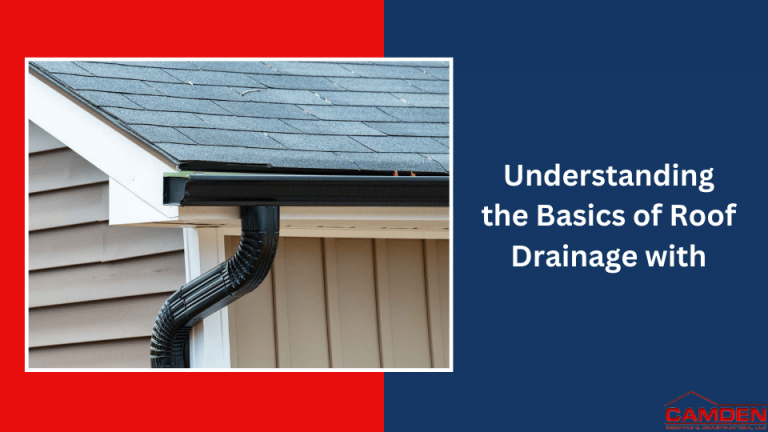Understanding the Basics of Roof Drainage with Camden Roofing & Construction. Roof drainage is a crucial aspect of every building’s design, as it helps protect the structure from water damage and ensures the longevity of the roofing system. Proper roof drainage is essential for directing rainwater away from the roof and foundation, preventing water infiltration, leaks, and structural issues. In this article, we will delve into the basics of roof drainage, including components, design considerations, and maintenance practices to keep your roof and home dry and resilient.

Components of Roof Drainage Systems:
To understand roof drainage, it’s essential to familiarize yourself with the key components that make up a typical roof drainage system:
- Gutters: Gutters are horizontal channels installed along the edge of the roof to collect rainwater runoff and direct it to downspouts. They come in various materials, such as aluminum, copper, and vinyl.
- Downspouts: Downspouts are vertical pipes connected to the gutters, responsible for transporting rainwater from the roof to the ground or drainage system.
- Leader Pipes: Leader pipes are extensions of downspouts that direct water away from the building’s foundation and into a designated drainage area.
- Scuppers: Scuppers are openings in the parapet wall or roof edge that allow excess water to flow off the roof.
- Splash Blocks or Drainage Pans: These components are placed at the base of downspouts to disperse water evenly and prevent erosion near the foundation.
Design Considerations:
Proper roof drainage design requires careful planning to ensure efficient water flow and minimize the risk of water damage. Here are some essential design considerations:
- Roof Pitch: The roof’s slope or pitch plays a significant role in roof drainage. Steeper roofs facilitate faster water runoff, while flatter roofs may require additional drainage measures.
- Gutter Size and Capacity: Choose gutters that can handle the volume of rainwater expected in your area. Larger gutters are more effective in areas with heavy rainfall.
- Downspout Placement: Place downspouts strategically to ensure even distribution of water away from the building’s foundation. Avoid long horizontal sections of gutters without downspouts.
- Leaf Guards and Screens: Install leaf guards or screens in the gutters to prevent debris buildup, which can block water flow and lead to overflow issues.
- Slope Away from Foundation: Ensure that the landscape surrounding your building slopes away from the foundation to prevent water from pooling near the structure.
- Foundation Drainage: Coordinate your roof drainage system with your foundation’s drainage system to ensure seamless water management and prevent basement flooding.
Common Roof Drainage Issues:
Understanding potential roof drainage issues can help you identify and address problems early, preventing costly damage. Some common issues include:
- Clogged Gutters: Debris like leaves, twigs, and dirt can accumulate in gutters, blocking the flow of water. Regular gutter cleaning is essential to prevent clogs.
- Overflowing Gutters: In heavy rain, gutters can overflow if they are unable to handle the volume of water. This can result in water damage to the roof, siding, and foundation.
- Improper Slope: If the roof’s slope is insufficient or uneven, water may pool on the roof’s surface, leading to leaks, deterioration, and structural issues.
- Inadequate Downspouts: Too few or improperly placed downspouts can result in uneven drainage, with some areas of the roof retaining water.
- Leaks and Water Infiltration: Damaged or poorly sealed gutters, downspouts, or seams can lead to water infiltration into the building’s interior.
Maintenance and Care:
Regular maintenance is crucial for ensuring the effectiveness of your roof drainage system. Here are some maintenance practices to consider:
- Gutter Cleaning: Clean your gutters at least twice a year, preferably in the spring and fall, to remove debris and prevent clogs.
- Inspect for Damage: Regularly inspect gutters, downspouts, and other drainage components for damage, rust, or loose connections. Repair or replace damaged parts promptly.
- Clear Debris: Trim overhanging branches to prevent leaves and twigs from falling into gutters. Remove any debris that accumulates on the roof.
- Adjust Downspouts: Ensure that downspouts are securely attached and direct water away from the foundation. Use downspout extensions if necessary.
- Check Seals and Joints: Inspect seals and joints for signs of wear or deterioration. Reapply sealant or replace damaged components as needed.
- Install Gutter Guards: Consider installing gutter guards or screens to minimize debris buildup in gutters.
Specialized Roof Drainage Solutions:
In some cases, specialized roof drainage solutions may be required to address specific issues or unique architectural designs:
- Flat Roof Drainage: Flat roofs require unique drainage solutions, such as internal drains or scuppers, to prevent water from accumulating and causing damage.
- Green Roof Drainage: Green roofs, which feature vegetation, require specialized drainage layers to manage excess water and support plant growth.
- Solar Panels and Skylights: The installation of solar panels or skylights may require modifications to the roof drainage system to prevent water infiltration around these fixtures.
- French Drains: In areas with poor natural drainage, a French drain system can be installed to redirect excess water away from the foundation.
Professional Assessment:
If you experience persistent roof drainage issues or are unsure about the adequacy of your drainage system, it’s advisable to consult with a roofing professional. They can assess your system, identify any problems, and recommend appropriate solutions to ensure efficient roof drainage and prevent water-related damage.
Conclusion:
Understanding the basics of roof drainage is essential for the protection and longevity of your home. A well-designed and properly maintained roof drainage system ensures that rainwater is directed away from the roof and foundation, preventing water damage, leaks, and structural issues. By implementing the right design considerations, addressing common issues, and performing regular maintenance, you can keep your roof and home dry and resilient for years to come.
For more information, contact Camden Roofing & Construction, LLC in Charlotte and Raleigh, NC, at 919-729-5050.
